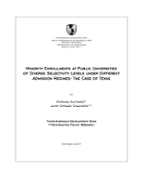Minority Enrollments at Public Universities of Diverse Selectivity Levels under Different Admission Regimes: The Case of Texas
Date
Oct 2007
This study describes how minority enrollment probabilities respond to changes in admission policies from affirmative-action to merit-only programs and then to percentage plans when the demographic composition of the potential pool of applicants is also shifting. It takes advantage of admission policy changes that occurred in the state of Texas with the Hopwood and HB588 decisions and of a unique administrative dataset that includes applications, admissions, and enrollments for three public universities of different selectivity levels. The findings suggest that the elimination of affirmative action and the introduction of the Top 10% plan had differential effects on minority enrollment probabilities as well as on application behavior depending on the selectivity level of the postsecondary institution. In particular, Hopwood is related to shifts in minority enrollments from selective institutions to less selective ones as the cascading hypothesis predicts. And although the Top 10% plan seems to have helped increased minority enrollment probabilities at the selective college as the upgrading hypothesis predicts, once the increases in minority shares among high-school graduates are taken into account, we find that the Top 10% plan can no longer be related to improvements in minority representation at selective universities.



